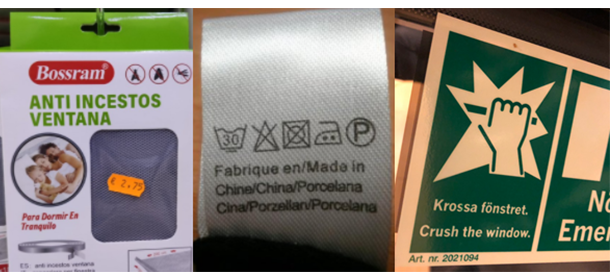Nobody notices a good quality translation. Everyone notices when it’s bad.
25 Mar 2021
 5 mins read
5 mins read

A window screen that in Spanish protects against incest instead of insects. A clothing label that thinks the country China is ‘porcelain’ in several languages. A Swedish sign instructing English speakers to ‘crush the window’. For an endless array of entertaining mistranslations, just head over to any social media platform and check out the #badtranslations or #translationfail hashtags.

Not always so funny
But poor translations can’t always just be found amusing, shared and forgotten. In 2001, an American manufacturer of baby formula had to recall 4.6 million cans of one of its products because the preparation instructions had been incorrectly translated into Spanish, creating a risk of severe illness if the Spanish instructions were followed. Although the problem was apparently caught before any babies suffered harm, it was a very expensive mistake.
And just last year, a social media platform was forced to issue a profound apology to the people of Thailand – and deactivate its auto-translate feature – after a short English message about the Thai king’s birthday was auto-translated into a post that caused huge offence.
Four ways to assure translation quality
Most of the examples we find amusing are the result of poor machine translation (MT), with no review by a human who properly understands the context and is fluent in both languages. The Thai example above shows why businesses should think very carefully before using MT without human post-editing.
But while adding a professional translator to the process is the first line of defence against embarrassment (or worse), the experience of the baby formula manufacturer shows that mistakes can still happen. As long as it takes humans to achieve quality in translation, we need to protect, as far as we can, against human error.
Here are four ways to do so.
1. Add minds to the process
Translation (or post-editing MT) without further review can be the right choice for certain types of content. But the greater the likelihood of error – or the more serious its potential consequences – the more you should consider adding one or more reviewers to the process.
A linguistic reviewer will assess issues of style and nuance as well as catch slipups in spelling, grammar and meaning. A reviewer who is a subject-matter expert (and speaks the target language) can assess the accuracy and appropriateness of specific terminology and claims.
Naturally it helps if translators and reviewers have good tools to achieve, assess and track quality. The computer-assisted translation (CAT) tool they use should include verification checks to help identify and fix common issues – relating, for example, to punctuation, formatting or special characters – so that the human focus can be squarely on getting the message just right.
2. Get consistent with terminology
You don’t want a reviewer – especially a subject-matter expert who may not be a translator – to unwittingly undo specific efforts by the translator or linguistic reviewer to employ brand-approved terminology consistently.
Inconsistent use of terminology may not be the worst mistranslation error to make, but it can cause confusion among the target audience. In a digital-first world where people have more choice than ever before, brands with clear, consistent messages in every language have a better chance to thrive.
Ideally you want everyone involved with translation – whether it’s a core or incidental part of their job – to have access to a well-maintained termbase. This can readily be achieved today with cloud-based terminology management tools that allow anyone with a browser to access the terminology information they need – increasing the chances of good, consistent translation. If you’re already using spreadsheet-based glossaries, it can be very easy to convert these to a termbase within a cloud translation environment.
When more people can access your termbase, it also widens the community who can meaningfully contribute to terminology decisions. This opens the way for building a robust, collaborative approval and update process for the terms you want to use and avoid – an important step in a mature quality assurance process.
3. Formalize quality assessment
Another way to mature your quality assurance process is to formalize the system used by linguistic reviewers to assess translations and provide feedback. This involves using a translation quality assessment (TQA) tool, which ideally is built into the translation process.
A TQA provides a framework for consistently categorizing and scoring the severity of errors in translation. This means that over time you can assess the quality of translation that you’re achieving across projects or track the progress of individual translators. It’s also a much more effective way to give meaningful feedback to translators, helping them to avoid choices that don’t work for your needs.
TQA functionality within CAT tools is still relatively new, which means you should be on the lookout for ongoing improvements in usability as developers focus on how to make the categorization and scoring process as user-friendly as possible. In our own implementation, for example, you can now choose not to have TQA popups on each amendment (previously the only way to do it). Instead reviewers can first complete their review, then step through all the amendments to categorize the errors for TQA.
4. Transcreation: use the right tools
One thing CAT tools haven’t traditionally been designed for is transcreation. So it’s good news to see this changing.
Transcreation can take the quality of high-value content to a new level, but it’s much more similar to content creation than translation. Translators who have been asked to transcreate will typically want to offer a number of different options, comment on the rationale for different choices, and potentially provide back-translations to help reviewers assess the accuracy and quality of the different options. It’s a big step forward to move these things to the CAT environment, because the CAT tool will automate a number of processes that make transcreation particularly labour-intensive to manage. Taking the effort out of transcreation management puts the focus firmly on achieving quality translations that hit the right note. And the transcreation will also be stored in translation memory, which can be valuable for future jobs (especially at the level of fragment matching).
Commit to quality
Any business that wants to avoid the worst blunders of machine translation should design a quality-focused localization process and use translation technologies that make it easier to assess and assure quality. The same applies to any business that wants to use transcreation to wow audiences in every language and culture. Wherever your translation needs lie on the spectrum from raw machine translation to transcreation, now is the time to ask yourself: are we getting quality control right?
Contact us to learn more about the tools that can help you.
